Many people love the joys that come with gardening. Are you one of them? Think about how many gardens you’ve seen in your life and what they looked like. A little four foot by four-foot box, a 2000 square foot in ground garden with perfectly spaced rows, hydroponic setups, or raised beds perfectly lined up it looks like a surveyor laid out the beds. Any way you look at it, people build their gardens to their satisfaction and that’s what makes every garden out there the right design. If it makes you happy as a gardener, then it’s good.
I tend to love a garden with variety and in partial disarray using a multitude of materials. Whimsy is important to me in the garden and makes for much more enjoyable experiences when I’m out there talking with my babies. It may seem weird, but I also think the plants enjoy it.
When I say a multitude of materials, here’s what I mean. It’s incredible how much trash we as a society generate and how much of that trash is usable for other uses—or upcycled. Why throw away something that will hold soil and provide a home for a few seeds and provide depth and variety in your garden?
One of my favorite “throwaways” I use in my garden are discarded garage door panels. A standard garage door panel is usually around 22 inches wide and if you get aluminum panels, your raised beds will last longer than you’ll likely live! If all you can find is old wood doors, place the door’s old exterior to the inner portion of the raised bed as that part is normally exposed to the elements anyway. I put several coats of a water based wood preservative on the soil exposed inner surface of each panel and a more traditional polymer type brand on the external panels. Two 16 foot garage doors make an excellent 4’ x 12’ raised bed with only two cuts at the 12 foot length required on each panel. And each panel usually has a wooden block every 4 feet for structure so this gives you a little meat to screw into when assembling the bed. I installed some angled sheet metal on each corner as a precaution, using self tapping metal roofing screws to ensure a sold structure.
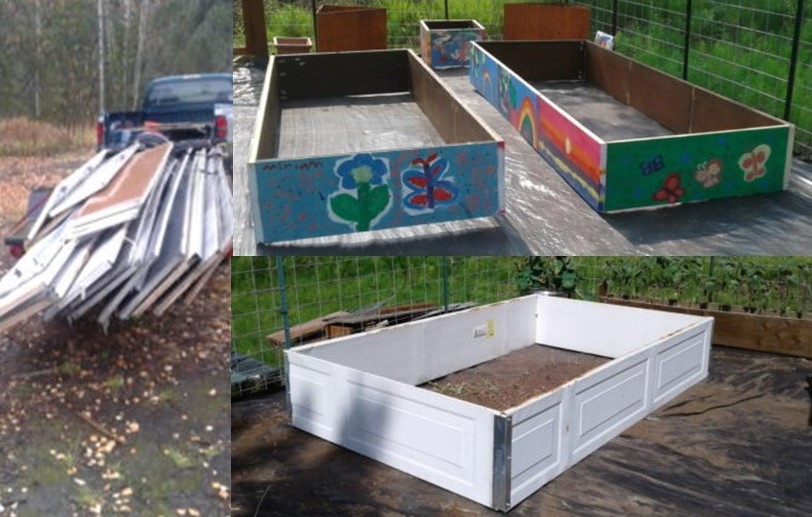
A few years ago when I was in the process of building my garden area, I had erected three sides of my fence when I noticed my neighbor had an old truck bed on a trailer full of miscellaneous scrap metal. I asked him what his plans were for all that and I had just caught him before as he was leaving for the scrap metal dealer. I asked him for the truck bed and he was more than happy to oblige. He came back from dumping the bed contents and we set the bed in my garden area where I thought would be a good spot. Thankfully I hadn’t put the fourth wall up from the fence. I drilled a bunch of holes in the bed for drainage and I now have a great free raised bed.

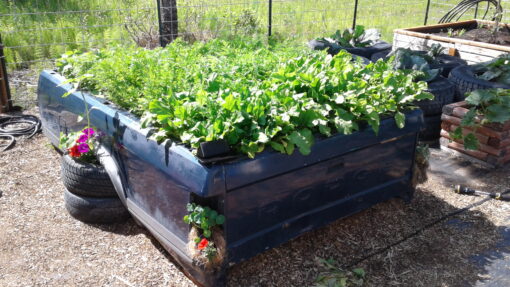
I also garden in old tires. This is controversial because they contain a variety of toxic chemicals that may leach into the vegetables. There have been practically no studies on this and my feeling is the risk is very minimal if non-existent, but if anyone has a personal concern, then don’t plant in old tires. Do what you are comfortable with. Tires have a couple of advantages. They are usually available for free from any tire dealer and they are happy to get rid of them. Larger commercial truck tires are the best as their extra diameter just makes for a roomier planting area, but I also have some regular car tires and even some smaller ATV size tires. They are great to fill a small open area in the garden where not much else will fit. I always stack them two high and fill the lower tire with leaves and grass and the upper tire with grass around the inside of the tire to keep from wasting soil to an area that will not be used to grow anything. I generally use the bigger tires to grow cabbage and squash. The tires absorb the heat of the sun and this makes it much easier to get squash to survive in the cool Alaska climate on the Kenai Peninsula.

Old pallets are another one of my favorite upcycled materials to use for my raised beds. I usually can get them free from many sources. I split the pallets to make about a two foot high panel and screw the sections together. Next I line the bed with a weed barrier or road fabric. This ensures soil doesn’t filter out through the panel slats and lessens the chance of the pallet wood rotting. And if you’ve ever looked, pallets seem to last forever in the worst weather conditions, so I’m confident these will be around a long time.
I could go on and on in describing different items I have in my garden for planting and the options are endless. The items I mention earlier are the big ticket throwaways that provide the largest area of planting space. If you noticed, I also make sure my raised beds are fairly high to make access and save my back from so much bending over. I always tell folks that the older I get, the further away the ground gets, so keeping the planting surface high is important to me. I fill most of my beds and larger containers first with about a foot of logs, leaves, grass, and brush (this is called Hügelkulter), then a foot of my favorite soil mix.
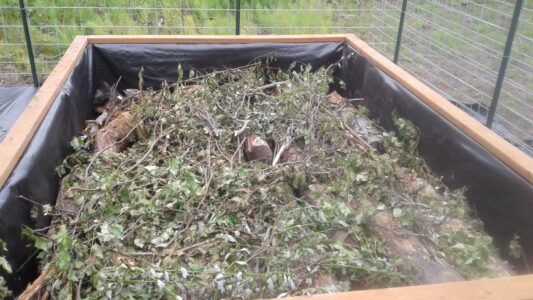
I also use a variety of small, upcycled items, for example, old electric teapots and coffee pots. Drill a few holes in the bottom for drainage and they are fun for planting herbs and flowers. I am sure everyone has purchased grapes or cherries at the store in those clear plastic bags with holes in them for airflow. These make great little greenhouses to start plants in and I like them for herbs.

The plastic trays rotisserie chickens come in make fantastic little greenhouses but most stores have gone to the plastic bags for those chickens now—darn it!! The plastic clamshells berries come in or snack tomatoes work great as starter pots. Just cut the lid off or leave the lids on for a perfect seed starting container.
And I love to grow potatoes and other crops in bags and free bags are everywhere for that purpose. Every home show, sport show, building show, etc., has vendors giving away the cloth shopping bags. These work great as pots. The handles make it easy to move them around and they will last several years.
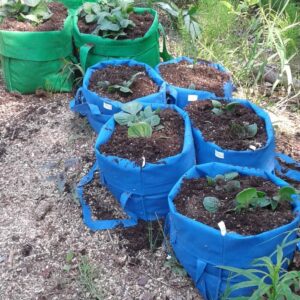
One item I am really looking forward to in 2021 is planting in an old small baritone tuba I have. I’m planning to drill a few holes for drainage, fill the bell with soil, and plant something that will trail out of the bell down along the body of the instrument. I just have to decide what that will be.
When we replaced an older washer dryer unit a few years ago, I took the dryer apart and used the tumble barrel to hold soil, and the old pedestals the front loaders sat on are used too. I grew onions in them last year.
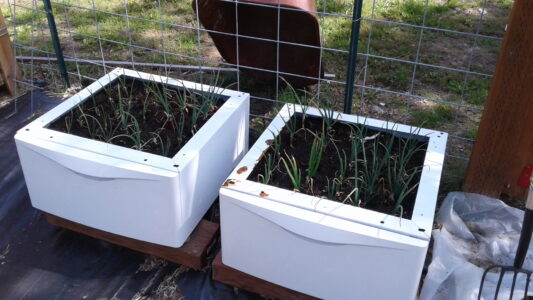
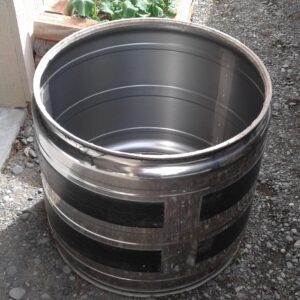
So when you are getting ready to take out the trash or head to the dump, take a look at what you are throwing away and if it will hold soil. Why not try using it to add a little whimsy to your garden, greenhouse, deck, or window sill. If anything, it makes for a good conversation item for friends who stop by. And, it’s just one more item that doesn’t go to the landfill. Give it a try and I think you’ll be surprised at what you’ll find once you start looking. Avoid using any container or material that might leach toxic chemicals into the soil. For more ideas on building raised beds, check out the UAF Cooperative Extension Service publication and video on the topic.
All photos are by the author.
About Larry Opperman
Twitter •
Why not line the tires with weed block or some kind of fabric then do your thing with grass, leaves, soil. You could even use plastic or irt. Might prevent any leaching.
I thought about that but the plastic or fabric would have to be water tight to not allow any leachate to pass through. I guess you could do that and then punch holes in the bottom of the liner to allow water to drain. Might consider that. Thanks, Larry
Great, i like it.
Thank You!
I enjoyed your article Larry and I never thought about using those plastic containers for seed starters.
I’m one of those people who have toured your garden and was so impressed with all the up-cycled items.
Thank you
Love the truck bed! You have an interesting collection of pots, I also love eclectic gardens.
I especially like the dryer drum and pedestals. Great idea